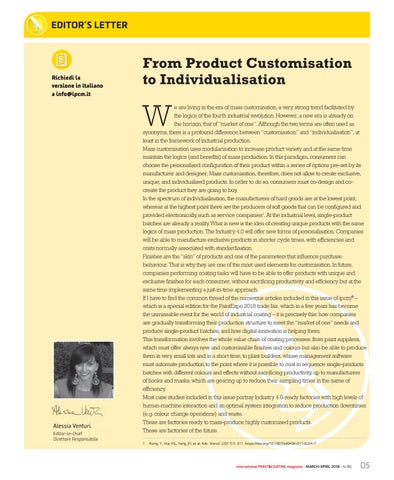EDITOR’S LETTER
Richiedi la versione in italiano a info@ipcm.it
From Product Customisation to Individualisation
W
Alessia Venturi Editor-in-chief Direttore Responsabile
e are living in the era of mass customisation, a very strong trend facilitated by the logics of the fourth industrial revolution. However, a new era is already on the horizon, that of “market of one”. Although the two terms are often used as synonyms, there is a profound difference between “customisation” and “individualisation”, at least in the framework of industrial production. Mass customisation uses modularisation to increase product variety and at the same time maintain the logics (and benefits) of mass production. In this paradigm, consumers can choose the personalised configuration of their product within a series of options pre-set by its manufacturer and designer. Mass customisation, therefore, does not allow to create exclusive, unique, and individualised products. In order to do so, consumers must co-design and cocreate the product they are going to buy. In the spectrum of individualisation, the manufacturers of hard goods are at the lowest point, whereas at the highest point there are the producers of soft goods that can be configured and provided electronically, such as service companies1. At the industrial level, single-product batches are already a reality. What is new is the idea of creating unique products with the same logics of mass production. The Industry 4.0 will offer new forms of personalisation. Companies will be able to manufacture exclusive products in shorter cycle times, with efficiencies and costs normally associated with standardisation. Finishes are the “skin” of products and one of the parameters that influence purchase behaviour. That is why they are one of the most used elements for customisation. In future, companies performing coating tasks will have to be able to offer products with unique and exclusive finishes for each consumer, without sacrificing productivity and efficiency but at the same time implementing a just-in-time approach. If I have to find the common thread of the numerous articles included in this issue of ipcm® – which is a special edition for the PaintExpo 2018 trade fair, which in a few years has become the unmissable event for the world of industrial coating – it is precisely this: how companies are gradually transforming their production structure to meet the “market of one” needs and produce single-product batches, and how digital innovation is helping them. This transformation involves the whole value chain of coating processes: from paint suppliers, which must offer always new and customisable finishes and colours but also be able to produce them in very small lots and in a short time, to plant builders, whose management software must automate production to the point where it is possible to coat in sequence single-products batches with different colours and effects without sacrificing productivity, up to manufacturers of hooks and masks, which are gearing up to reduce their sampling times in the name of efficiency. Most case studies included in this issue portray Industry 4.0-ready factories with high levels of human-machine interaction and an optimal system integration to reduce production downtimes (e.g. colour change operations) and waste. These are factories ready to mass-produce highly customised products. These are factories of the future. 1
Wang, Y., Ma, HS., Yang, JH. et al. Adv. Manuf. (2017) 5: 311. https://doi.org/10.1007/s40436-017-0204-7
international PAINT&COATING magazine - MARCH/APRIL 2018 - N. 50
05
